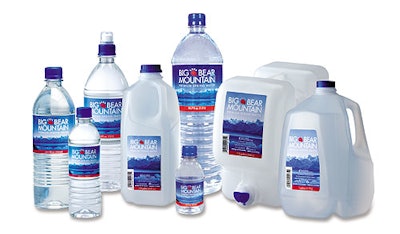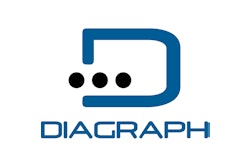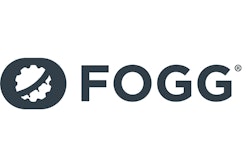When the San Manuel Band of Mission Indians decided to bottle and market the water that flows from mountain springs on their California land, they didn’t mess around. Not only did they hire some of the most experienced marketing and operations people in water and beverage bottling. They instructed them to spare no expense in building and equipping their gleaming new plant.
“The tribe’s attitude was, ‘We’re in this for the long haul and we’re going to succeed, so don’t cut corners in the plant,’” says Peter Willis, chief executive officer and general manager of Highland, CA-based San Manuel Bottled Water Group.
Most impressive in the 56ꯠ-sq’ facility is the PET line, which fills 1.5-L bottles at speeds to 350/min. “That may not be soft drink speeds, but it’s not bad,” says Willis.
Throughout the plant, line design, equipment supply, and project management were the responsibility of Mateus Sales Co. (www.mateussales .com). “I’ve worked with them on other installations. It was clear in my mind right from the start that without them, we don’t do the project,” says Willis.
Automation is certainly a hallmark of the new line. Just five operators are required. “That’s probably three or four fewer than you’d likely expect on a bottling line of this size and capacity,” says plant manager Jim Huff.
Equipment selection, of course, makes automation possible. The Priority One Packaging Machinery (www.prioritypackaging.com) Pro-Pal bulk bottle depalletizer at the head of the line is a good example. Most functions, including the all-important sweep of bottles from the pallet onto a mass-flow discharge conveyor, are performed at or below eye level. Operators can easily see machine status without climbing to observe an overhead operation. That gives an operator time to pitch in on tasks that might otherwise have to be handled by a second operator.
Unlike some highly automated bottling lines, this line is also quite versatile, handling 8-oz, ½-L, 700-mL, 1-L, and 1.5-L bottles. Such versatility will be useful: San Manuel does some contract packaging in addition to filling its own brand. Bottle size changeover should take about an hour and 20 minutes once the crew grows used to the still-new equipment, says line integrator Dave Mateus.
Multipacking options
The line’s versatility is perhaps best illustrated by all the options it affords in multipacking. A Model SPO-40-V multipacker from Kisters Kayat (www.kkiusa.com) collates and shrink wraps unsupported bottles, bottles in trays, or bottles on flat pads. In addition to clear film, it can also handle printed film in register. Running at 40 cycles/min, it operates in a single-bundle format for 1- and 1.5-L bottles. But smaller bottles are run in a twin-bundle, side-by-side mode. To switch from single to twin, operators merely adjust lane guides so that what was once a center guide becomes a side guide. “It’s a quick and simple changeover,” says Mateus.
Downstream from the first shrink-wrap system, a Kisters Kayat PTF case/tray packer automatically puts bundled multipacks into corrugated trays and then sends trays through a Kisters Kayat SW-200 tray wrapper. Or in some cases, the upstream SPO-40-V is bypassed so that loose bottles can be collated and tray-packed on the PTF case/tray packer and shrink-wrapped on the SW-200 unit.
Film labels
Labeling is of interest from a materials standpoint. The cut-and-stacked labels, supplied by Inland Printing (www.inlandprinting.com), are applied with hot melt glue. But unlike most cut labels fed from a magazine, these are made of clear oriented polypropylene that’s only 1.9 mils thick. Reverse printing is done on a gravure press in six colors.
“This label produces a see-through effect that gives the bottle a nice look and feel, especially when the light hits it,” says Willis.
Comparable alternatives, adds Huff, were certainly evaluated. But clear-film pressure-sensitive labels would have been more costly, and roll-fed film labels don’t lend themselves to multiple bottle-size changeovers the way cut and stack labels do, says Huff.
According to Inland Label’s Roman Artz, OPP cut-and-stacked labels are a fairly recent development. Artz adds that a proprietary coating applied on the roll-fed gravure press gives the otherwise flimsy labels a certain stiffness and a desirable slip property. Without these characteristics, machineability could be a problem.
As aggressive as the firm was in equipping its new plant, management stopped short of self-manufacturing PET bottles. According to Willis, the logistics and cost of running an in-house bottle-making operation made outsourcing a more appealing option.
Supplied by Ball Corp. (www.ball.com), the PET bottles arrive in bulk on pallets. After depalletizing, the mass of bottles is gradually narrowed to a single file so that an air conveyor can transport them to the filling room. Like many of the conveyor connections in the line, the air conveyor was supplied by Alliance Industrial Corp. (800/368-3556). It supports bottles by the neck ring and uses jets of air to whisk them forward. “The air conveyor section isn’t very long,” says Huff. “But it’s the best way to be sure you don’t have a down bottle, which can really jam things up at the rinser/filler/capper system.”
That system is inside a separate room that’s overpressured with filtered air to keep airborne particulates out. Also contributing to the purity of the bottled product is a rinse of each bottle with ozonated spring water just before filling. The ozone gas mixed into the rinse water reduces bacteria counts, says Willis.
Processing, too, aims at delivering product purity. In fact, San Manuel is believed to be the first bottled water plant to use PureBright® broad-spectrum pulsed-light technology from PurePulse Technologies (www.purepulse.com). Found more commonly in the pharmaceutical field than the beverage world, PureBright technology inactivates in seconds any pathogens that might be in the water.
Rinser/filler/capper
The rinser/filler/capper block inside the filling room is from Fogg Filler (www.foggfiller.com). It has 50 rinsing heads, 42 filling valves, and 14 capping stations. It’s among the first monoblocks built by Fogg, a company well-known for liquid fillers. Fogg also supplied the cap elevator/orienter. Like the bottle rinser, the cap-handling system also rinses caps with ozonated water. It handles both the flat and the sports caps used by San Manuel.
Exiting the overpressured filling room, bottles pass through a Filtec inspection system from Industrial Dynamics (www.filtec.com) that rejects any bottle with an improper fill level or a missing or cocked cap. Following an Alliance bi-directional accumulation table, labeling is done by a Langguth Model E62 12/6-24 machine from Germany’s Langguth GmbH, represented in North America by Priority One. The labeler has an unusually small footprint that measures just 49½”x56½”. Its compact size is partly due to the fact that it requires no glue roller or recirculating glue pot. Instead it uses a three-nozzle Nordson (www.nordson.com) system to spray hot melt glue onto the bottle. When the bottle rotates past the label magazine, it pulls one label with it. The full-wrap label is wrapped around the bottle, and then another three-nozzle set of glue applicators sprays glue on the trailing edge of the label to complete the labeling process.
Immediately following the labeler is a Lasetec laser coder from Industrial Dynamics. It codes the shoulder of each bottle with a date code. Huff appreciates the system’s ability to create fully formed characters instead of the dot-matrix style of imprint that some laser systems produce. “It’s a nice, clean, readable code,” says Huff.
Options
Once past the laser coder, bottles can be conveyed through the Kisters SPO-40-V bundler or bypass it altogether. On the day Packaging World viewed the line, 1.5-L bottles were bypassing this bundler and moving straight into the Kisters PTF case/tray packer. This machine collated bottles into 12-count groups and loaded them into corrugated trays. Trays were conveyed past a Diagraph Corp. (www.diagraph.com) ink-jet system that coded opposite sides of each tray with date and lot number. Next, the Kisters SW-200 tray wrapper encased each tray in a clear film wrap. Though not being applied on the day of PW’s visit, printed shrink film can be applied in register by the SW-200.
Palletizing and stretch wrapping are all that remain. Trays are conveyed to the palletizer on a zero-pressure accumulation conveyor from HK Systems (www.hksystems.com). The Priority One Pro-Pal Mini palletizer resembles the upstream depalletizer in that it also operates on a low-level, as opposed to overhead, basis.
Empty pallets are automatically advanced from a magazine. For each pallet layer, the palletizer collates the correct number of bundles required by a layer and then pushes the layer onto a floor-level transfer plate. This plate rises or descends to whatever level is necessary, and then a sweep mechanism sweeps the layer onto the preceding layer.
Full pallets are conveyed out of the palletizer and directly into a Wulftec (www.wulftec.com) Model WCRT-125 Futura stretch wrapper that marks the end of the automated line.
Although it’s only been operating since March of this year, the PET line is running smoothly, says Willis. So are the other two lines, he adds, one for 5-gal bottles and the other for 2.5-, 1-, and ½-gal bottles made of HDPE (see sidebar).
Willis believes the plant startup went as smoothly as it did partly because all three lines were designed “harmoniously,” as he puts it. Just as important, he adds, “We hired good people.”




































